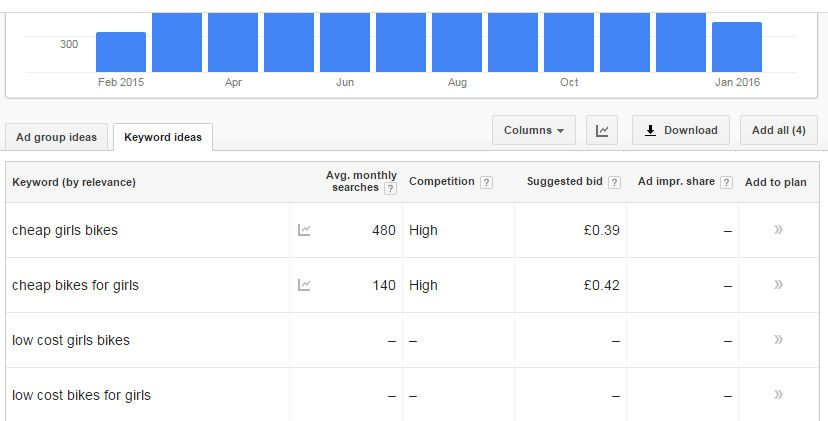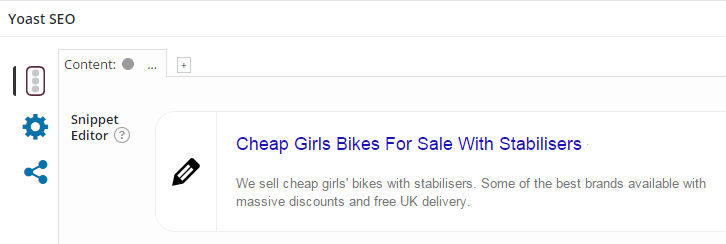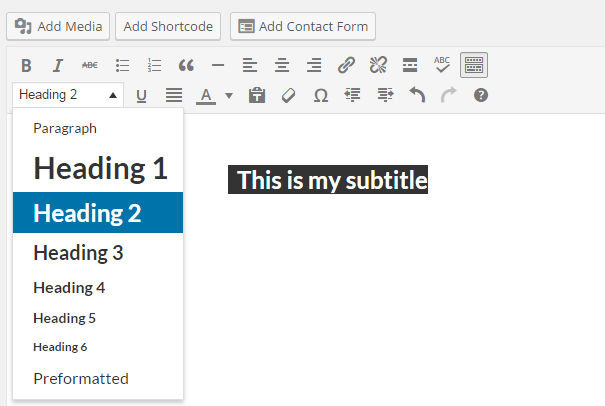Search engine optimisation (SEO) is the act of making your web content easy for search engines to find and understand. The better you optimise, the easier it is for Google, Bing, Safari and other engines to see how relevant your content is to someone’s search. A well-optimised site can increase the chances of your web pages and posts ranking highly in search results, boosting the number of visitors to your site. In this post, we’ll explain a few simple things you can do to optimise your content.
- Find the right keywords
Before you can begin to optimise your site, you have to have an understanding of the nature of keywords and key phrases. Keywords and key phrases are the specific words people use when searching the internet. For example, if someone wanted to purchase a bike for their daughter they would probably search for girls bikes or girls cycles. In addition, they may add other criteria to make the search more specific, such as, cheap girls bikes with stabilisers or cheap bikes for girls with stabilisers. When a person submits a search query, search engines look for web pages which contain those keywords or phrases, looking for the best match. Although keywords and phrases are not the only criteria they take into consideration, those web pages which are optimised for those keywords will usually rank higher than those that do not. As a website owner, one of your tasks will be to make sure that you know which relevant keywords and phrases are being used by searchers on the internet so you can include them in your content. You can do this by using Google’s Keyword Planner. As you can see from the image below, taken from the keyword Planner, some keywords are used far more frequently than others. By looking at the chart above, you can clearly see that most people search for cheap girls bikes and that the numbers searching for low cost girls bikes are so small Google can’t even quantify them. For a website owner, this research is gold dust. It means that you know which keywords are going to generate business and which ones will not. As a result, you know which terms to include in your web content to get ranked more highly.
By looking at the chart above, you can clearly see that most people search for cheap girls bikes and that the numbers searching for low cost girls bikes are so small Google can’t even quantify them. For a website owner, this research is gold dust. It means that you know which keywords are going to generate business and which ones will not. As a result, you know which terms to include in your web content to get ranked more highly. - Optimising the title
Now that you understand how keywords and phrases work and have researched which terms to use, you can begin to optimise your page or post title. You should always include the keywords in your title and place them as near to the beginning as possible. The reason for this is that search engines see titles as an indicator of the web page’s content. If the term is important enough to be in your title and near the beginning, it means that the content should be focused around that keyword. Using our bike example, above, our title should be something like Cheap Girls Bikes For Sale with Stabilisers.
You should always remember that search engines have limits on the number of characters they display in search results (this varies depending upon the query and on the device being used), so it is important to keep your title short. As a rule, you should aim to do the following:- Keep the title to less than 55 characters.
- Make sure that it makes sense, as people will need to read and understand it.
- The more important they keywords or phrase, the nearer to the beginning it should go.
- Optimising the meta description
After looking at the title, the next area that a search engine will focus on is the meta description. A meta description is a brief description of the content of your web page and is usually presented to searchers as a snippet underneath the title in search results. Meta descriptions can be created using HTML, but the easiest way to create them with WordPress is to use the free Yoast SEO plugin. Yoast provides you with an input area where you can type your meta description. It will also tell you how well you have optimised the meta description. Bearing in mind that the meta description will need to be written in a user-friendly way, it should contain your keyword or phrase near the beginning and also include any other important information that is likely to get searchers to click through to your site. Meta descriptions should be a maximum of 156 characters in length anything else will be cut off. As a result, they need to be written concisely.
Bearing in mind that the meta description will need to be written in a user-friendly way, it should contain your keyword or phrase near the beginning and also include any other important information that is likely to get searchers to click through to your site. Meta descriptions should be a maximum of 156 characters in length anything else will be cut off. As a result, they need to be written concisely. - Optimising the content
Once you have optimised the meta description, you will then need to optimise the content of your web page or post. The first thing you should do is to make sure that you have the keyword or phrase placed in the first paragraph of the content. Search engines pay special attention to first paragraphs because they usually function as an introduction, telling the reader what the rest of the page will be discussing. If they keyword isn’t in the introduction, it’s unlikely to be an important element of the content and so the search engine won’t rank it as highly. The second factor is to improve the keyword density. Keyword density is the percentage of times a keyword or phrase occurs in the content of a web page. Generally speaking, if your keyword has a high density a search engine is more likely to see your page as being relevant. Our bikes page, therefore, should have the term cheap girls bikes used sporadically throughout the piece. However, you need to be careful here. If you deliberately overuse the keyword in a bid to get search engines to rank you more highly, you are using a technique called keyword stuffing. This can lead to your page being ignored by search engines or, at worst, lead you to being penalised and having your whole site disappear from any search results. Luckily, the Yoast SEO plugin will inform you if you have a high enough keyword density and tell you if you are overusing a keyword. If you do not use Yoast, you should err on the side of caution and only use keywords naturally within your content.
The final element of optimisation within the content is to include alternative keywords and what are known as long tail keywords. Alternative keywords are less popular keywords that still have a lot of searches. If you look at the research we undertook with Google Keyword Planner at the beginning of this article, you will notice that the two most searched for terms were cheap girls bikes and cheap bikes for girls. We chose cheap girls bikes as our focus keyword because it was likely to generate more traffic. However, we should also use cheap bikes for girls within the content to give the page a chance at ranking for that term too. Long-tail keywords are longer, specific phrases that people might search for, for example, cheap bikes for young girls, best cheap girls bikes deals or bargain cheap bikes for young kids. Long tail keywords are not searched for in high numbers and so not many website owners spend time optimising for them. However, if you have included them in your content when others haven’t, you are more likely to rank more highly in those searches. Optimising for long-tail keywords can be a very useful technique for websites which don’t rank very well for high traffic keywords. - Optimising your subtitles
You should always use subtitles to divide up longer web content as it helps readers navigate more easily through your page. For SEO purposes, it is not necessary to have your main keyword in every subtitle; it can even be counter-productive to do so. However, your subtitles should do two things: firstly, they should accurately summarise the section of content which follows and secondly, they should be displayed as h2 headers. If your subtitle relates to your main title, the search engine will see this as a positive when ranking your site. However, it will only know it is a subtitle if it is formatted using a h2 tag. You can create a h2 header very simply in WordPress. All you have to do is highlight the subtitle text, click on the format text drop-down box and select Heading 2.
Conclusion
The information provided in this article will have given you a much better understanding of how to optimise the content of your web pages and posts for search engines. You should:
a) Understand how to research and find relevant keywords
b) Be able to write more effective titles, subtitles and meta descriptions
C) Know how to embed keywords within pages and posts without resorting to keyword stuffing
You should also be aware that although optimising the content of your posts will help improve your chances of ranking more highly, it is only one of many factors that search engines use to rank search results.
If you are looking for dedicated WordPress hosting, visit our WordPress Hosting page. We offer a range of feature-packed, affordable packages, expert WordPress support and first-class security.



